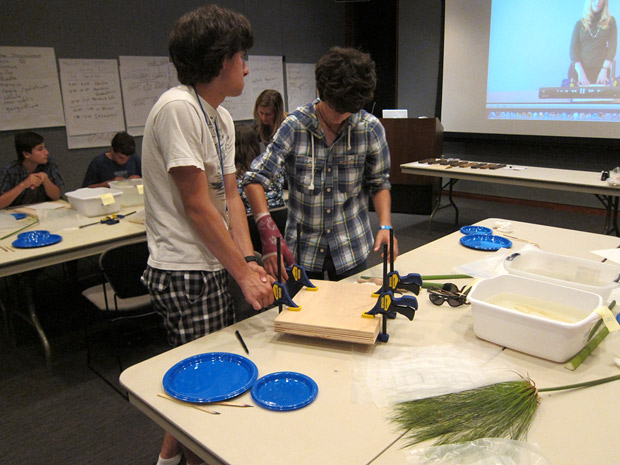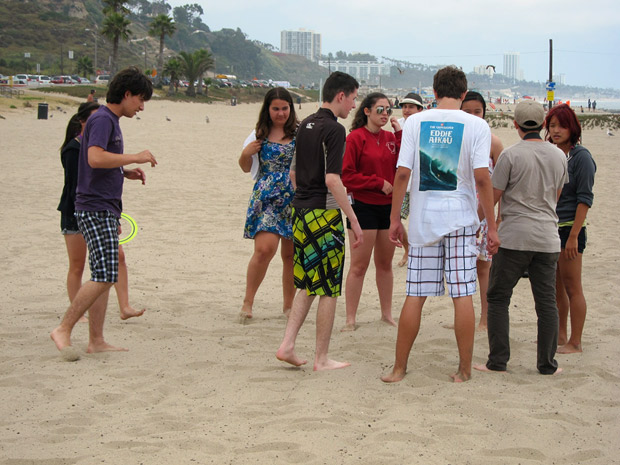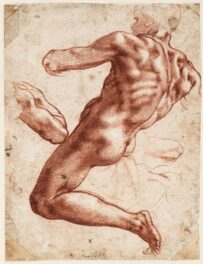If you visited the Getty Villa during the week of July 25 and thought you overheard people speaking Latin, you weren’t imagining things. That week, we at the Getty Villa were proud to invite a group of 14 high school students to the Museum for our first-ever week-long, semi-immersion Latin course, the Academia Aestiva Latina (Summer Latin Academy).
In collaboration with SALVI (North American Institute for Living Latin Studies) and Latin instructor Luke Henderson of Santa Monica High School, we sponsored the Academia to offer students of Latin an opportunity to delve deeply into the language, while benefiting from the historically significant context of the Getty Villa as a Roman house.
Pairing the instruction of Latin with the Getty Villa’s collection, architectural spaces, and gardens allowed educators to more effectively illuminate the Latin vocabulary and its connection to Roman material culture. Completion of the program would ensure that students appreciated Latin not as a “dead tongue,” but rather as a dynamic living language that could be studied (and spoken!) outside of a classroom. This video by Luke shows how fun learning Latin turned out to be for the participants.
Students from nine high schools in Southern California joined in the program, which combined classroom instruction with exploration of the Villa. “Surface vs. Reality” was the theme of the week. We focused students’ attention on aspects of Roman domestic life and their impact on the Romans—and on us today. The idea that Roman society was not always what it appeared was one that the students could relate to, even 2,000 years later.
The first two classes on Monday and Tuesday provided students with an introduction to the Getty Villa museum and its gardens—in Latin, of course. In the mornings, students discovered Roman architecture and the natural world through activities that familiarized them with vocabulary they’d encounter during afternoon sessions. Topics covered during these mornings ranged from a consideration of how space might affect mood to the agrarian origins of the Romans. Exploration of the Museum’s spaces and gardens took place in the afternoons, when members of the Villa Education team offered tours, activities, and games designed to reinforce and provide context for the morning lessons.
For example, students took turns playing the roles of the different members of the extended family that would have made up a Roman household. They also explored the beautifully manicured gardens to procure enough herbs for their own bouquets garnis. Although traditionally used to season foods such as boar, porpoise, or pig, these bouquets were, several students declared, perfect for car air fresheneners instead! Now that’s Roman ingenuity.

Students from the Academia Aestiva Latina show off their bouquets garnis in the Getty Villa’s Herb Garden
Class time over the next two days looked at the family and communication. Wednesday’s review of the Roman and modern families was well received by students, who could relate closely to what we know about the ancient family: key to any good family was, and is, the ability to communicate with one another. Thursday’s morning session explored how the ancient Romans communicated using ancient technologies such as roads, paintings, and papyrus to expand their influence across the Mediterranean.
Our afternoon activities on Wednesday and Thursday engaged the students in more hands-on exploration. Gallery teachers Sabina Miller and Chelsea Hogan developed a scavenger hunt into a competitive game, in which students had to identify objects in the Museum’s collection that would have been owned by a wealthy Roman and his family. Students went through the galleries with a fine-toothed comb trying to locate silver drinking horns, coins, and ancient toys for a chance to win t-shirts and other prizes. The following day, Sabina showed the students how papyrus had been manufactured in the ancient world, and students were given their own papyrus strips to make sheets—which they then used to assume the role of Roman travelers writing to their families 2,000 years ago. For ink, they used an ancient recipe of water and carbon ash.

Josh and Michele press their newly-made sheet of papyrus
The final day of Latin Academy focused on the sea, ancient water deities, and the importance of the natural world underwater. Wondering why we would investigate this seemingly unrelated topic? Because the second half of the day was a trip to the beach!
Students were rewarded for their hard work and dedication with a trip to Will Rogers State Beach. The goodwill that this trip fostered ensured that both students and instructors alike left with smiles on our faces, Latin in our hearts, and sand in our swimsuits!
We at the Getty Villa are looking forward to June 2012, when the Academia Aestiva Latina will once again take place at the Museum during the week of June 25. If you’re a high-school student studying Latin and are interested in applying to the program, please contact me via email at ebruehl@getty.edu.
In annum venturum! (Until next year!)

Students from the Getty Villa’s Academia Aestiva Latina at Will Rogers State Beach




Comments on this post are now closed.